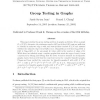Free Online Productivity Tools
i2Speak
i2Symbol
i2OCR
iTex2Img
iWeb2Print
iWeb2Shot
i2Type
iPdf2Split
iPdf2Merge
i2Bopomofo
i2Arabic
i2Style
i2Image
i2PDF
iLatex2Rtf
Sci2ools
JCO
2007
2007
Group testing in graphs
This paper studies the group testing problem in graphs as follows. Given a graph G = (V, E), determine the minimum number t(G) such that t(G) tests are sufficient to identify an unknown edge e with each test specifies a subset X ⊆ V and answers whether the unknown edge e is in G[X] or not. Damaschke proved that log2 e(G) ≤ t(G) ≤ log2 e(G) + 1 for any graph G, where e(G) is the number of edges of G. While there are infinitely many complete graphs that attain the upper bound, it was conjectured by Chang and Hwang that the lower bound is attained by all bipartite graphs. Later, they proved that the conjecture is true for complete bipartite graphs. Chang and Juan verified the conjecture for bipartite graphs G with e(G) ≤ 24 or 2k−1 < e(G) ≤ 2k−1 + 2k−3 + 2k−6 + 19 · 2 k−7 2 for k ≥ 5. This paper proves the conjecture for bipartite graphs G with e(G) ≤ 25 or 2k−1 < e(G) ≤ 2k−1 + 2k−3 + 2k−4 + 2k−5 + 2k−6 + 2k−7 + 27 · 2 k−8 2 − 1 for ...
JCO 2007 | Minimum Number | Paper | Unknown Edge |
| Added | 15 Dec 2010 |
| Updated | 15 Dec 2010 |
| Type | Journal |
| Year | 2007 |
| Where | JCO |
| Authors | Justie Su-tzu Juan, Gerard J. Chang |
Comments (0)

